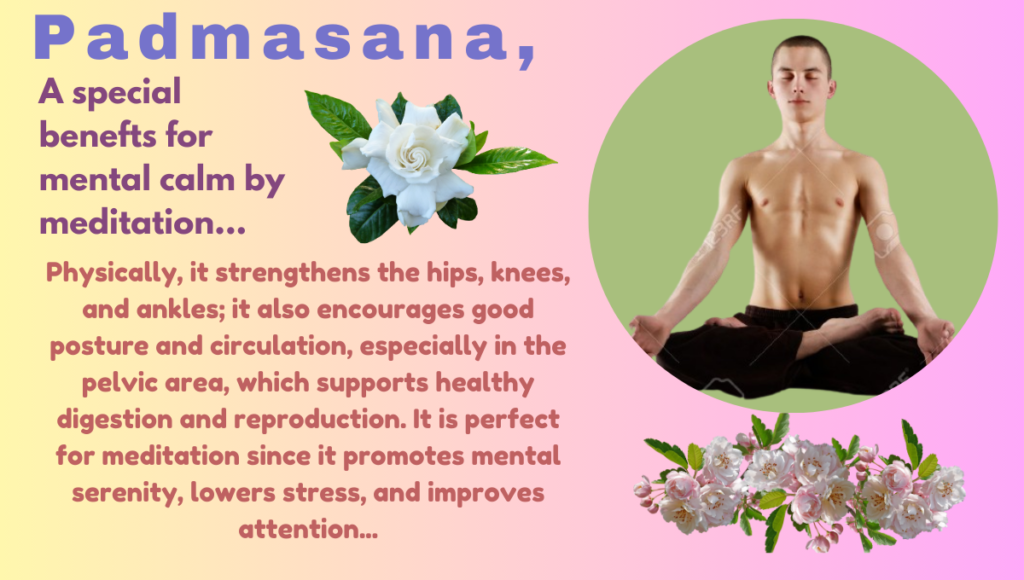Padmasana’s Benefits__
What is Padmasana ?_(Intro. to-Lotus pose)__
- In yoga, Padmasana, also referred to as Lotus Pose, is a highly regarded seated pose with numerous physical and psychological advantages.
- The Sanskrit terms “padma,” which means lotus, and “asana,” which means stance or posture, are the source of the term “Padmasana“.
- With each foot resting on the thigh of the opposing person, this asana creates a solid, symmetrical sitting position that resembles the shape of a lotus flower.
- This pose promotes balance, stability, and grounding inside the body as each foot rests on the thigh of the other.
- There are several different and comprehensive “Padmasana’s Benefits”. In terms of physical benefits, the position increases flexibility in the knees, ankles, and hips, which can result in better posture and less physical strain.
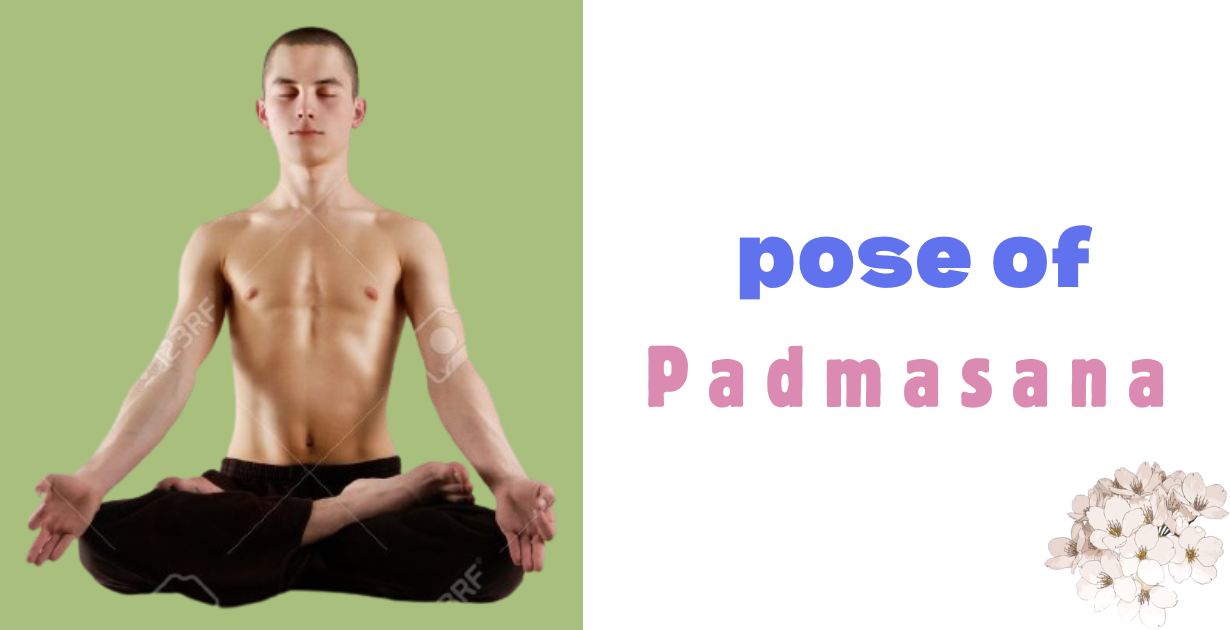
- The “Padmasana’s Benefits” extend beyond its health benefits. Physically, it improves ankle, knee, and hip flexibility, which helps with posture and spine alignment.
- This better posture is perfect for people who spend a lot of time sitting down because it eases the tension on the neck and back. Furthermore, Padmasana enhances blood circulation, particularly in the pelvic area, which supports the regulation of reproductive and digestive processes.
- There are significant psychological and emotional “Padmasana’s Benefits”.
- It is regarded as a meditative stance that promotes inner serenity, eases tension, and quiets the mind.
- Regular practice of Padmasana helps improve mental clarity, attention, and concentration, which facilitates the experience of connecting with higher states of consciousness.
- Padmasana is a potent tool that has several advantages for anyone wishing to improve their general well-being or their meditation practice.
Padmasana: A blessing for Mental clarity__
- Padmasana enhances mental clarity and a heightened sense of inner serenity by encouraging a balanced and peaceful posture.
- The “Padmasana’s Benefits” go beyond improved physical flexibility; they also provide a special benefit for meditation depth.
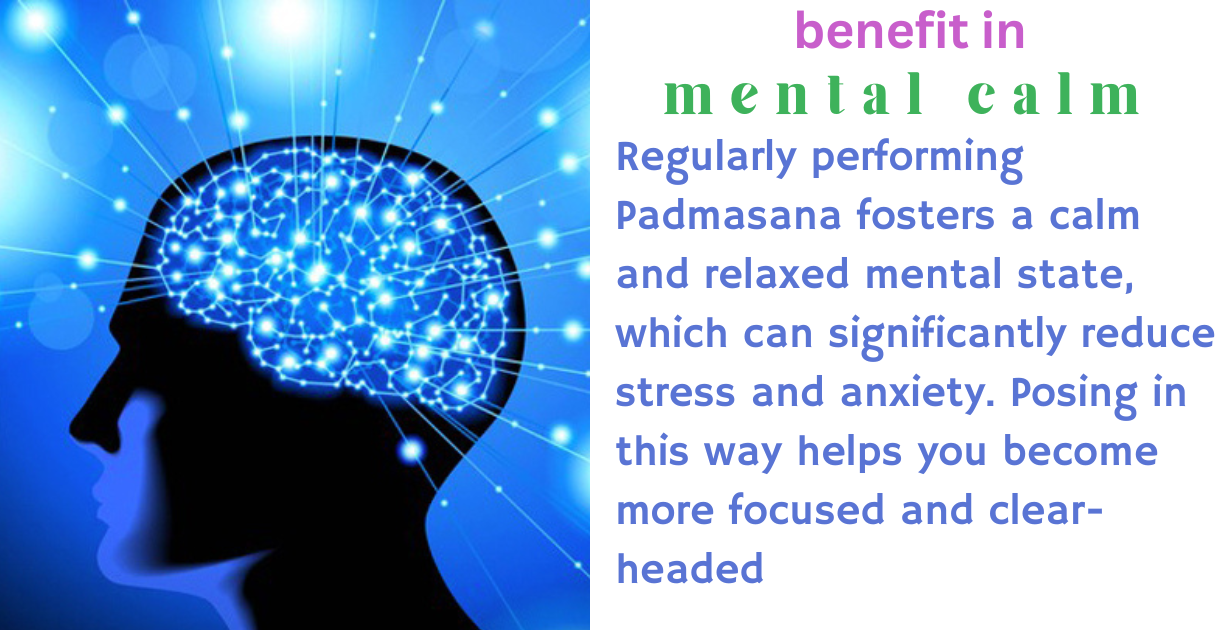
- Regularly performing Padmasana fosters a calm and relaxed mental state, which can significantly reduce stress and anxiety.
- Posing in this way helps you become more focused and clear-headed, which facilitates connecting with higher realms of consciousness during meditation.
- This mental peace increases the efficacy of mindfulness exercises and promotes general emotional well-being.
For Whom Is Padmasana Practice Necessary ?
- For those using pranayama or meditation, Padmasana, also known as the Lotus Pose, is highly advised since it enhances focus and helps to relax the mind.
- It is very helpful for anyone looking for inner calm and mental clarity. Stretching the knees and ankles, improving posture, and improving focus are some of the “Padmasana’s Benefits”.
- Because of its great ability to stabilize the body during meditation, this pose enables practitioners to sit for extended periods of time without experiencing any discomfort.
- Padmasana can be difficult without the right flexibility, therefore people with knee or hip problems should exercise caution when attempting the position.
Read more__
A unique Padmasana’s Benefits_increase concentration power__
- The traditional meditation pose of padmasana facilitates the development of a stable, grounded sitting position. To stay focused throughout meditation sessions, this steadiness is necessary.
- You can improve your meditation experience and develop a closer relationship with yourself by doing Padmasana, which will increase your focus and mental clarity.
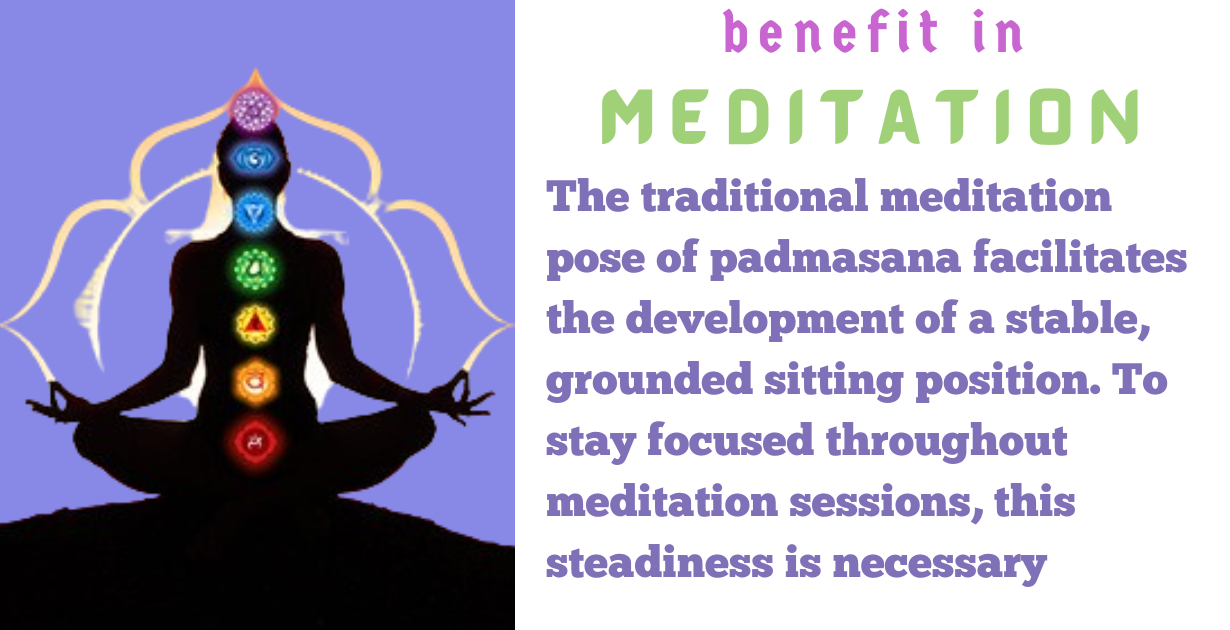
- The “Padmasana’s Benefits” are numerous and include improvements in mental clarity and physical flexibility. Including this position in your practice will help you achieve a more harmonious and balanced state of wellbeing.
How to Prectice Padmasana:
- Padmasana, or Lotus Pose, is a well-known yoga posture with numerous benefits, including improved circulation, enhanced flexibility, and mental peace. To make the most out of Padmasana, follow this step-by-step tutorial:
- Choose a Cozy Place to Sit: To begin, take a seat on the floor with your legs out in front of you. Ensure that your sitting bones are firmly grounded and that your spine is straight.
- If you need to elevate your hips while sitting, you can use a yoga block or cushion. The seated yoga pose known as Padmasana, or Lotus Pose, is well-known for its calming benefits on the body and mind.
- To perform Padmasana, just take these easy steps: With your legs out in front of you, take a seat on the floor. With the sole of your foot facing upward, rest your right foot on your left thigh while bending your right knee.
- Then, with the sole pointing upward, place your left foot on your right thigh while bending your left knee. Maintain a straight back, relaxed shoulders, and hands resting on your knees with the palms facing up. Shut your eyes and concentrate on your thoughts.
Some important Precautions About Practicing Lotus Pose__
- The Lotus Pose, or Padmasana, is a very helpful yoga pose. However, in order to maximize the advantages of Padmasana and prevent injury, it’s vital to take some precautions.
- Warm-Up:Make sure to warm up your body with gentle stretches, focusing on the hips and legs, before attempting Padmasana. This lessens the chance of straining tense muscles.
- Flexibility:The hips, knees, and ankles must be flexible for this pose. Avoid forcing yourself into the position if your joints are stiff. Begin with simpler versions like as Ardha Padmasana (half-lotus).
- Prevent Pain:Stop right away if you experience any severe knee, hip, or ankle pain. Attempting to endure discomfort can result in severe harm.
- Injury History: If you have had previous injuries in your knees, hips, or lower back, consult a yoga expert before practicing Padmasana. Modify the pose or avoid it if necessary.
- Proper Posture: Always sit with a straight spine to avoid back strain. You can use a cushion under your hips for support.
- Following these precautions will help you enjoy the full benefits of Padmasana safely, improving your flexibility, calming the mind, and promoting inner peace.
Another Most Important “Padmasana’s Benefits”___
- The highly regarded yoga pose known as Padmasana, or Lotus Pose, has significant psychological and physical advantages. The following are the top five “Padmasana’s Benefits”:
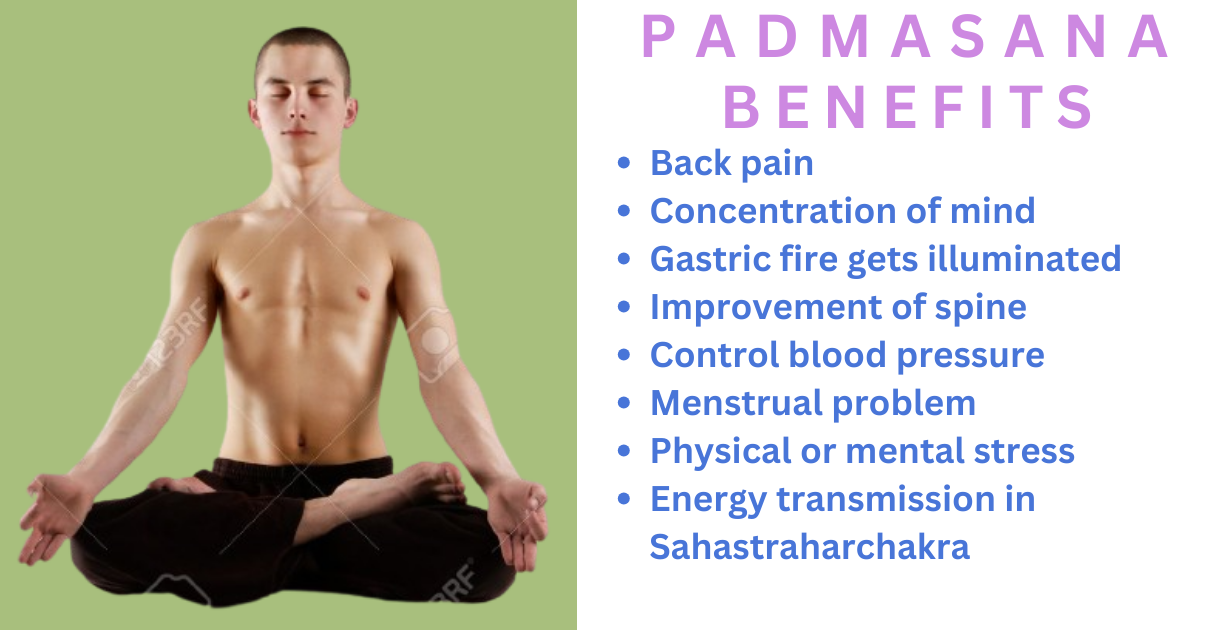
Increased Flexibility and Joint Health:
- Improving hip, knee, and ankle flexibility is one of the main “Padmasana’s Benefits”.
- Preventing stiffness and preserving joint health depend on this increased flexibility. Your range of motion can be gradually increased by performing Padmasana on a daily basis.
- This improves joint function overall and lowers the chance of injury.
Better Posture and Spinal Alignment:
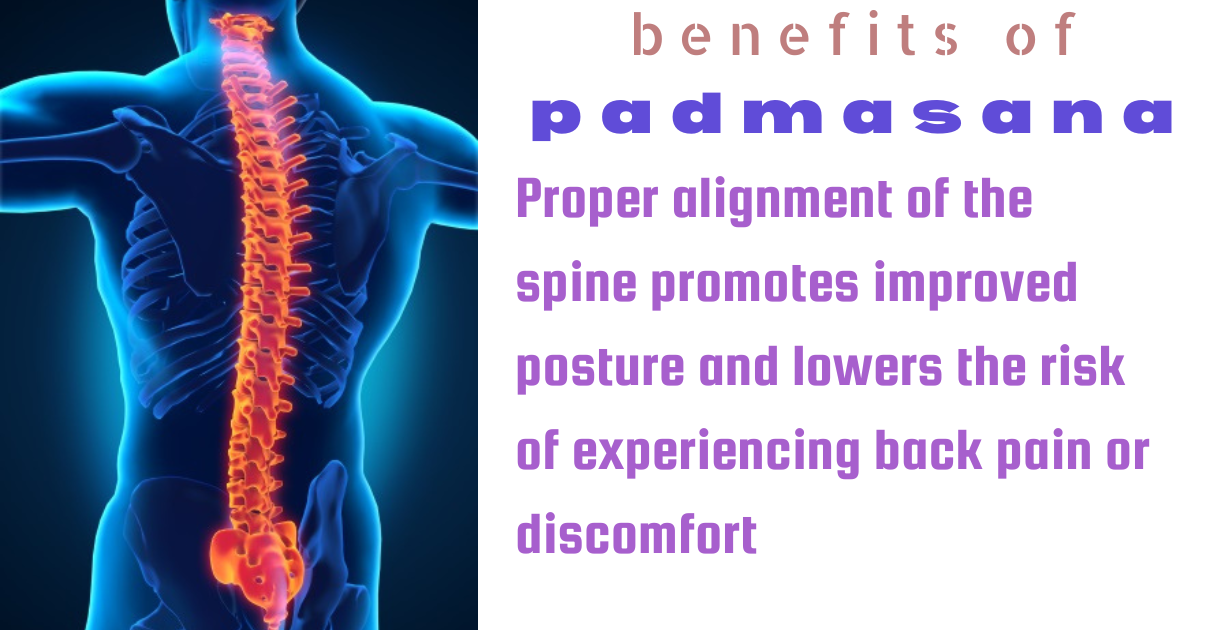
- By encouraging a firm, sturdy base for the spine, padmasana aids in appropriate spinal alignment. For people who spend a lot of time sitting down, this alignment eases the tension on their neck and back.
- Proper alignment of the spine promotes improved posture and lowers the risk of experiencing back pain or discomfort.
Improved Digestive Health and Circulation:
- One of the “Padmasana’s Benefits” is enhanced blood circulation, especially in the pelvic area. The reproductive and digestive systems may benefit from this improved circulation.
- Increased blood flow promotes healthy digestion and can ease problems with the reproductive system, which makes padmasana a beneficial exercise for equilibrium and internal health.
Improve Mental peace:
- The significant effect that Padmasana, or Lotus Pose, has on improving meditation practice is one of its unique “benefits.” The “Padmasana’s Benefits” go beyond improved physical flexibility; they also provide a special benefit for meditation depth.
- Long-term meditation sessions can help you stay focused and concentrated by creating a stable, grounded basis using this pose. Padmasana enhances mental clarity and a heightened sense of inner serenity by encouraging a balanced and peaceful posture.
- Padmasana is a vital practice for anyone looking for a more profound meditation experience because it not only helps with meditation quality but also opens up a deeper connection with one’s inner self.
Conclusion:
Ultimately, the “Padmasana’s Benefits” are both physical and mental, making it a fundamental practice in yoga. Physically, it strengthens the hips, knees, and ankles; it also encourages good posture and circulation, especially in the pelvic area, which supports healthy digestion and reproduction. It is perfect for meditation since it promotes mental serenity, lowers stress, and improves attention. Padmasana is a physical and mental strengthening exercise that promotes inner serenity and general well-being. Because of its tremendous effect on meditation, it is an effective tool for people who want to become more self-aware and clear-headed.
FAQ:
- By what additional name is Padmasana recognized ?
Kamalasana is another name for Padmasana. - The “Padmasana’s Benefits” are what ?
Padmasana has many advantages, such as better digestion, increased focus, spine alignment, reduction of stress, relief from back pain, and support for menstruation, pregnancy, celibacy, blood pressure control, weight loss, knee health, digestive health, and sexual health. - How long is it appropriate to perform Padmasana ?
First, one can practice padmasana for five to ten minutes, then progressively extend the time dependent on one’s ability. - Which illnesses is Padmasana able to treat ?
Numerous conditions can be relieved by padmasana, such as blood pressure difficulties, tension, impotence, menstrual disorders, chronic constipation, acidity, and knee problems. - Whom is Padmasana not advised for?
People who have sciatica, arthritis, back discomfort, or knee trouble should avoid padmasana.

